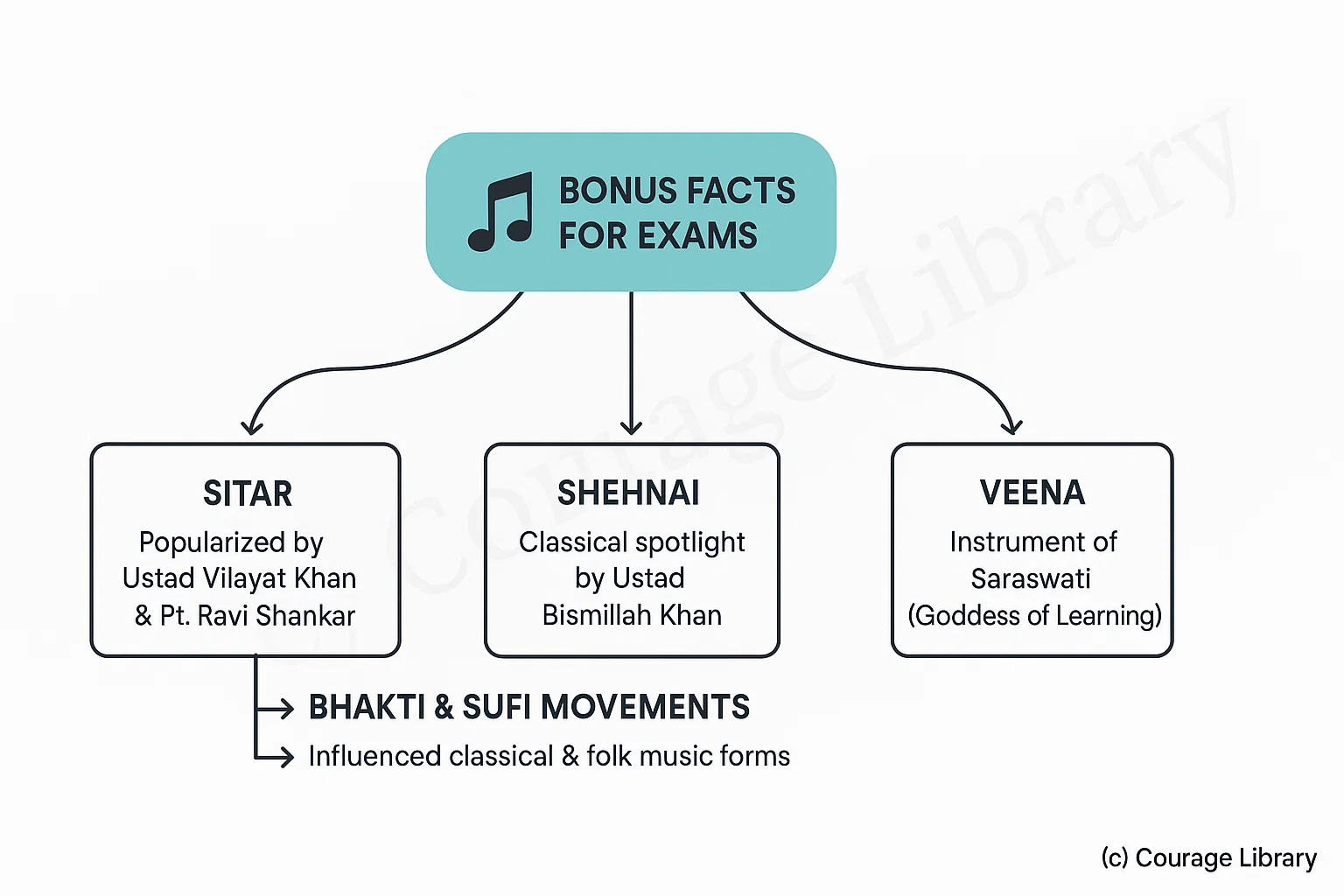SSC CGL - Detailed Guide 2025
Self-Paced Course

Music – Classical and Folk
Reference: Lucent GK, NCERT Class 6–12
Classical Music of India
India’s classical music is broadly categorized into two traditions: Hindustani (North) and Carnatic (South). Both emphasize raga (melody) and tala (rhythm), but differ in style, structure, and instruments.
| System | Region | Key Features |
|---|---|---|
| Hindustani | North India | Based on improvisation; uses ragas and talas; khayal & dhrupad styles; evolved in Mughal courts |
| Carnatic | South India | Compositional-based (kritis); devotional themes; fixed structure; linked with Bhakti movement |
Elements of Classical Music
| Element | Hindustani | Carnatic |
|---|---|---|
| Raga | Melodic framework for improvisation | Same concept; more rigid in rendition |
| Tala | Rhythm cycle (e.g., teental – 16 beats) | Tala cycles like Adi tala (8 beats) |
| Vocal Forms | Khayal, Dhrupad, Thumri, Tappa | Kriti, Varnam, Kirtanam |
| Key Composers | Tansen, Bhatkhande, Vishnu Digambar | Tyagaraja, Muthuswami Dikshitar, Shyama Shastri |
Classical Music Instruments (with system association)
| Instrument | Type | Hindustani / Carnatic |
|---|---|---|
| Sitar | String | Hindustani |
| Tabla | Percussion | Hindustani |
| Sarod | String | Hindustani |
| Shehnai | Wind | Hindustani |
| Veena | String | Carnatic |
| Mridangam | Percussion | Carnatic |
| Flute | Wind | Both |
Folk Music of India
Folk music is deeply connected to daily life, festivals, and rural traditions. It varies widely by region and community.
| Form | Region | Key Features |
|---|---|---|
| Bhavageet | Karnataka, Maharashtra | Emotional songs on love, nature, devotion |
| Baul | Bengal | Mystic folk music; spiritual, inspired by Sufi & Vaishnav thought |
| Lavani | Maharashtra | Fast tempo, powerful rhythm; women-centric, social themes |
| Dandiya | Gujarat | Associated with Navratri; rhythmic stick dance with song |
| Qawwali | North India (Sufi) | Devotional song form; uses harmonium, tabla, clapping |
| Bhajan | Pan-India (Hindu) | Devotional songs in praise of deities; simple melodies |
| Sufi Songs | Punjab, Delhi, UP | Spiritual, mystic, focused on divine love |
Musical Instruments of India
Categorized by how sound is produced:
| Category | Instruments | Key Notes |
|---|---|---|
| String (Tantu Vadya) | Sitar, Veena, Sarod | Melody producers; plucked or bowed |
| Wind (Sushir Vadya) | Shehnai, Flute | Used in classical and folk; flute linked with Lord Krishna |
| Percussion (Avanaddh Vadya) | Tabla, Mridangam, Dholak | Maintain rhythm; Dholak widely used in folk & bhajans |
Bonus Facts for Exams:
- Sitar was popularized by Ustad Vilayat Khan & Pt. Ravi Shankar.
- Shehnai was brought into classical spotlight by Ustad Bismillah Khan.
- Bhakti & Sufi movements influenced both classical and folk music forms.
- Veena is regarded as the instrument of Saraswati (goddess of learning).

Developed By Roopasree Challa
Next
Start Your SSC CGL Journey Now!
Join Courage Library to experience disciplined study and expert support.
Be a Couragian!